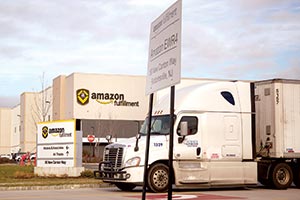Amazon Posts First-Quarter Gains, Ramps Up Fulfillment Network

This story appears in the May 8 print edition of Transport Topics.
Amazon.com reported double-digit growth in net income and revenue for the first quarter.
For the period ended March 31, the online retailer’s net income surged to $724 million, or $1.48 per share, compared with $513 million, or $1.07, in the 2017 first quarter.
Revenue increased 23% to $35.7 billion, compared with $29.1 billion in the year-ago period. Excluding a $492 million unfavorable impact from year-over-year changes in foreign exchange rates throughout the quarter, net sales increased 24% compared with a year earlier.
Revenue in North America rose to $21 billion compared with $17 billion a year earlier.
Based in Seattle, the company announced a new clean energy initiative to install large-scale solar systems on fulfillment center rooftops around the world.
“The company plans to complete installations on 15 facilities in the U.S. by the end of 2017 and complete the deployment of solar systems on 50 global fulfillment and sortation centers by 2020,” according to an April 27 statement.
Chairman and CEO Jeff Bezos said there’s a lot of optimism about the investment in front of the company.
“We continue to ramp [up] those investments,” he said. “In North America, that manifests itself mostly in the device area, the content area and also the expansion of the fulfillment networks,” said Chief Financial Officer Brian Olsavsky during a conference call with analysts.
“There’s over 50 million items that people can get delivered to their doorstep within two days or, in some cases, next day or same day,” he continued.
Amazon, he said, is seeing network efficiencies with the addition of sort centers that consolidate and sort packaged orders by ZIP code prior to delivery.
That has allowed Amazon to extend its cutoff times to midnight from 3 p.m. in most cases, he said. “So, [we have] greater control of our processes.”
In the quarter, net shipping costs — which includes sortation, delivery center and transportation costs — climbed to $4.4 billion compared with $3.3 billion, according to Amazon.
The company expects the cost of shipping to continue to rise if customers use its shipping offers at an increasing rate, it reduces shipping rates, it uses more expensive shipping methods, Amazon said.
Also, Amazon now has 18 freight-carrying planes and has announced rights to lease up to 40 planes, he said.
“So it’s gone very well,” he added.
At the same time, Amazon has “great relationships” with third-party carriers.
“We value all our partner relationships as we develop our own capability particularly in intranetwork,” Olsavsky said.
The company did not respond for a request to confirm whether in April it has placed a sizable order for Class 8 trucks and how they would be used in its network.
Its guidance for the second quarter calls for revenue between $35.25 billion and $37.75 billion, or an increase between 16% and 24% compared with last year’s second quarter. The company said it anticipates an unfavorable impact of about $720 million from foreign exchange rates.
Meanwhile, U.S. consumers ranked the company No. 1 in the American Customer Satisfaction Index, a 10,000-person poll that measures perceptions of quality and value across retailers nationwide, Amazon said.

